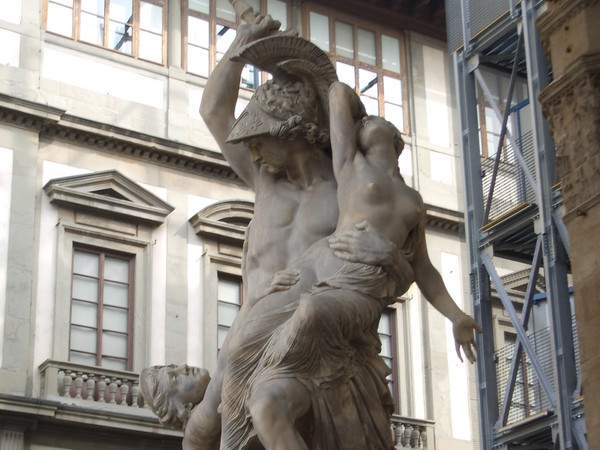From Nov. 24, 2018 to March 10, 2019, the Uffizi dedicates an exhibition to one of the masterpieces of mid-nineteenth-century art: the Rape of Polyxena sculpted by Pio Fedi (Viterbo, 1816 - Florence, 1892). A work so important that, as the American writer and actress Anna Cora Ritchie recalled, Florentines addressed the question “have you seen Fedi’s group?” to foreign visitors who came to Florence between the spring and summer of 1865. At that time Florence, from being the seat of the Grand Duchy of Tuscany, was becoming the capital of the new Kingdom of Italy: to celebrate its rise, spectacular national celebrations dedicated to Dante Alighieri were underway. In May, to coincide with the unveiling in Piazza Santa Croce of the statue of the "Supreme Poet," Pio Fedi, in his studio on Via de’ Serragli, unveiled to the public the colossal marble group of the Rape of Polyxena, now alongside Cellini and Giambologna in the splendid Loggia dei Lanzi in Piazza della Signoria.
The Uffizi exhibition, titled The Rape of Polyxena - Pio Fedi Classical Sculptor in the Years of Florence Capital, curated by Simonella Condemi and Elena Marconi, aims to evoke that evocative setting the artist wanted in his studio: thus, in the cosy and refined environment of the Sala del Camino, clay sketches and some preparatory drawings for the marble group will be on display, reconstructing the stages of a difficult and complex path to reach the final drafting of the monumental group, destined to decree Pio Fedi’s glory in Italy and abroad.
This small exhibition will be an opportunity to admire works not always exhibited together with a valuable new acquisition for the Galleries’ collections, and will allow Pio Fedi to be put in the light he deserves: for his fame is linked not only to the Rape of Polyxena in the setting of Piazza della Signoria, but also to the figure of the rayed Liberty for the Funeral Monument to Giovanni Battista Niccolini in the basilica of Santa Croce, which served as inspiration for the French sculptor Frédéric Auguste Bartholdi for his Statue of Liberty, the celebrated symbol of New York City.
In the grandiose sculptural group in the Loggia dei Lanzi, the image of the defenseless Polyxena, in the grip of the vengeful violence of Pyrrhus who is about to kill her, is elected to symbolize the women who in every age have suffered the brutality of men.On the occasion of the Day Against Violence Against Women, the Uffizi is organizing a conversation with Professor Valeria Andò on Sunday 25 entitled “A Beastly Violence. Models of the human in poetry, literary production and plastic representation of the themes proper to ancient epics and dramaturgy.”
For all information you can click this link.
Pictured: Pio Fedi, Rape of Polyxena (1850-1855; Florence, Loggia dei Lanzi)
 |
| An exhibition in Florence dedicated to Pio Fedi's Rape of Polyxena |
Warning: the translation into English of the original Italian article was created using automatic tools. We undertake to review all articles, but we do not guarantee the total absence of inaccuracies in the translation due to the program. You can find the original by clicking on the ITA button. If you find any mistake,please contact us.